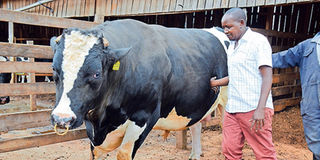Premium
That veterinary quack is just a phone call away, watch out

A livestock farmer inspects a bull.
What you need to know:
- Given the long period the animal stayed with the injury, one end of the fractured bone had pierced surrounding tissues and the skin leading to infection and gangrene formation.
- Recently, I got another call from a dairy cattle farmer, thanks to my contacts courtesy Seeds of Gold. A newly calved third lactation Friesian cow had her rear leg injured just above the hoof, below the hock joint.
- On review days later, the gangrene was found to have extended proximally and a decision on a second amputation was due.
- Any individual not having a valid KVB card is a quack and must not be allowed to touch animals let alone chickens.
Not long ago, I got a call from a farmer rearing cattle and dairy goats. She had a sick billy that had been treated for over a month but was not getting better.
I rushed to the farm and I was given history of the animal after which I carried out a general physical examination. I settled on an injury below the ‘knee’ of the front leg.
The leg was swollen, painful, hot, appeared bluish and was oozing pus. Apparently, the buck had its front leg slip through the timber on the floor of its unit and injured it. It was, therefore, unable to put weight on the affected leg.
A ‘vet’ had administered some injections a couple of times. On gently twisting the leg, holding either side of the wound, there were crepitations, those crackling or grating sounds indicative of a fracture.
Given the long period the animal stayed with the injury, one end of the fractured bone had pierced surrounding tissues and the skin leading to infection and gangrene formation.
I discussed the case with farmer and the options we had, namely amputation at the ‘knee’ joint, or slaughter. The farmer objected to both.
I realised that this farmer did not just keep the animals for their productivity; there was some sentimental value as well. She did not want the animal to suffer any further and asked that I euthanise it. She disappeared into her house so that she does not to see the animal die.
She instructed her workers to cut the head once the animal was dead and get it preserved so that she could hang it on the wall in her house. The rest of the carcass was to be buried.
he distraught workers asked that I allow they slaughter it normally, then bury so that later they could exhume and share the meat. I declined the request. The head was cut off as instructed and the rest of the carcass buried. I visited the farm weeks later to check on how the farmer was coping with her loss; all was well.
Recently, I got another call from a dairy cattle farmer, thanks to my contacts courtesy Seeds of Gold. A newly calved third lactation Friesian cow had her rear leg injured just above the hoof, below the hock joint.
She was a 40 litres a day beauty, in her first month post calving. Like the goat farmer, this cow meant more to the family than the ‘milk factory’ that she was.
After the injury, the farmer had called a local ‘vet’ to manage the case. The ‘vet’ applied a cast of sorts and administered some treatments.
ANIMAL'S QUALITY OF LIFE
The next day, the cast was broken. A second ‘vet’ was called in, who also applied a plaster of Paris (POP). But because an animal remains an animal, it would continue to struggle until the POP started breaking. The farmer then used improvised splints of wood to support the leg. The cow wasn’t looking too good and so further help was sought. I was given a brief on the case on phone, complete with WhatsApp pictures.
This case was far from my area of jurisdiction and so I recommended an experienced colleague to check it out. On examination, the leg was looking bad with protruding bones and very extensive gangrene.
It was rotting. This farmer opted for amputation which was carried out. The plan was to get the cow some prosthetic limb after her wound recovered.
On review days later, the gangrene was found to have extended proximally and a decision on a second amputation was due.
When I was consulted, my advice was that any further amputation was going to affect the animal’s quality of life and its ability to exhibit normal behaviour. It was now more about the welfare of the cow. Slaughter or euthanisation were the only options.
In my view, each of these two animals would probably have survived had proper treatments been timely. The injuries would have recovered reasonably well had the initial service providers on realising the scale of the injuries referred the cases to more experienced colleagues immediately.
The veterinary world, just as others in the country, has been infiltrated by quacks who unsuspecting farmers call to treat their animals.
Quacks treat by trial and error, injecting anything and everything, hoping the animal recovers.
Usually, by the time a farmer realises and calls the right individual, it is often too late. Some farmers also try out the science of treating for themselves and only call the vet when the case gets hopeless.
The practice of veterinary medicine in Kenya is regulated by the Kenya Veterinary Board (KVB). This body issues all qualified individuals an identification card that a farmer can demand to see whenever in doubt.
Any individual not having a valid KVB card is a quack and must not be allowed to touch animals let alone chickens.
Always confirm because not everybody with a stethoscope, syringe and needle is a vet.
Dr Muchibi is a veterinary surgeon and the animal health manager at Elgon Kenya Ltd. He also practices in Kitengela.





